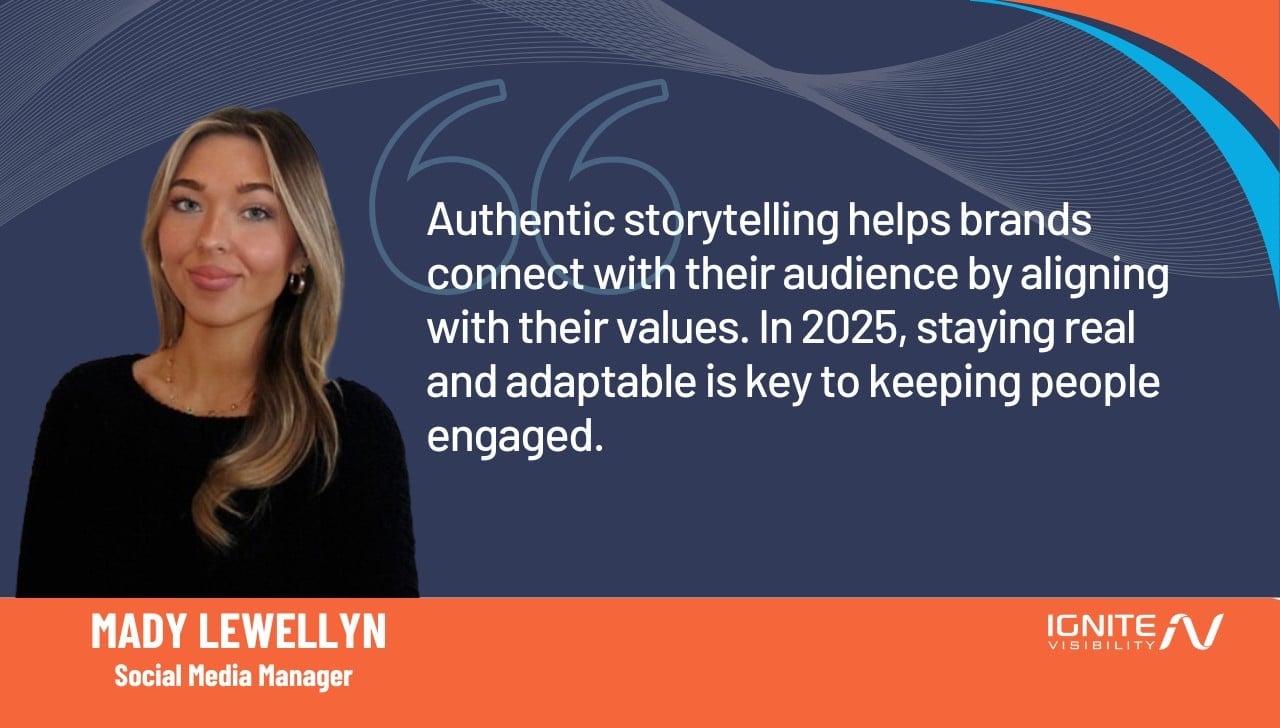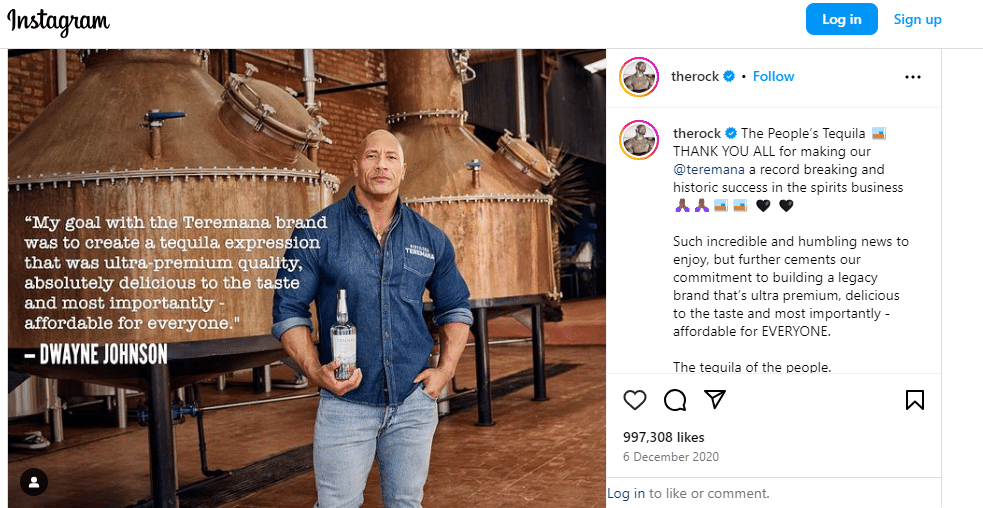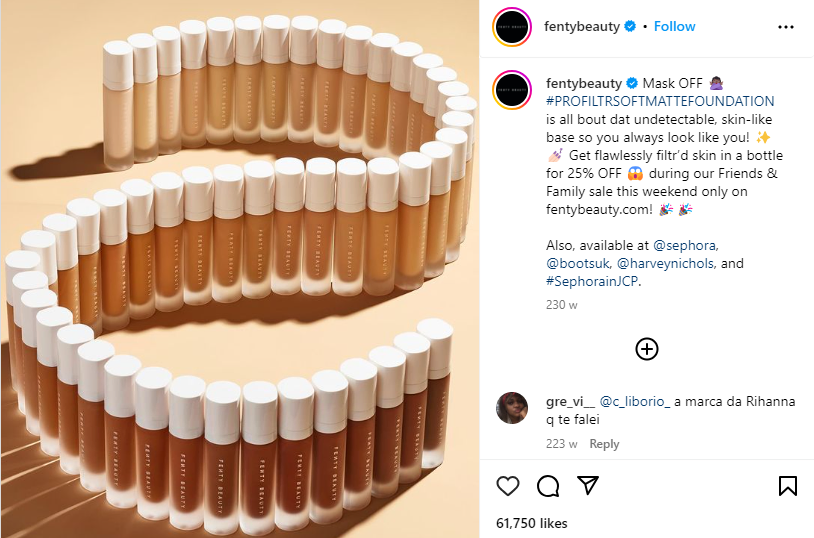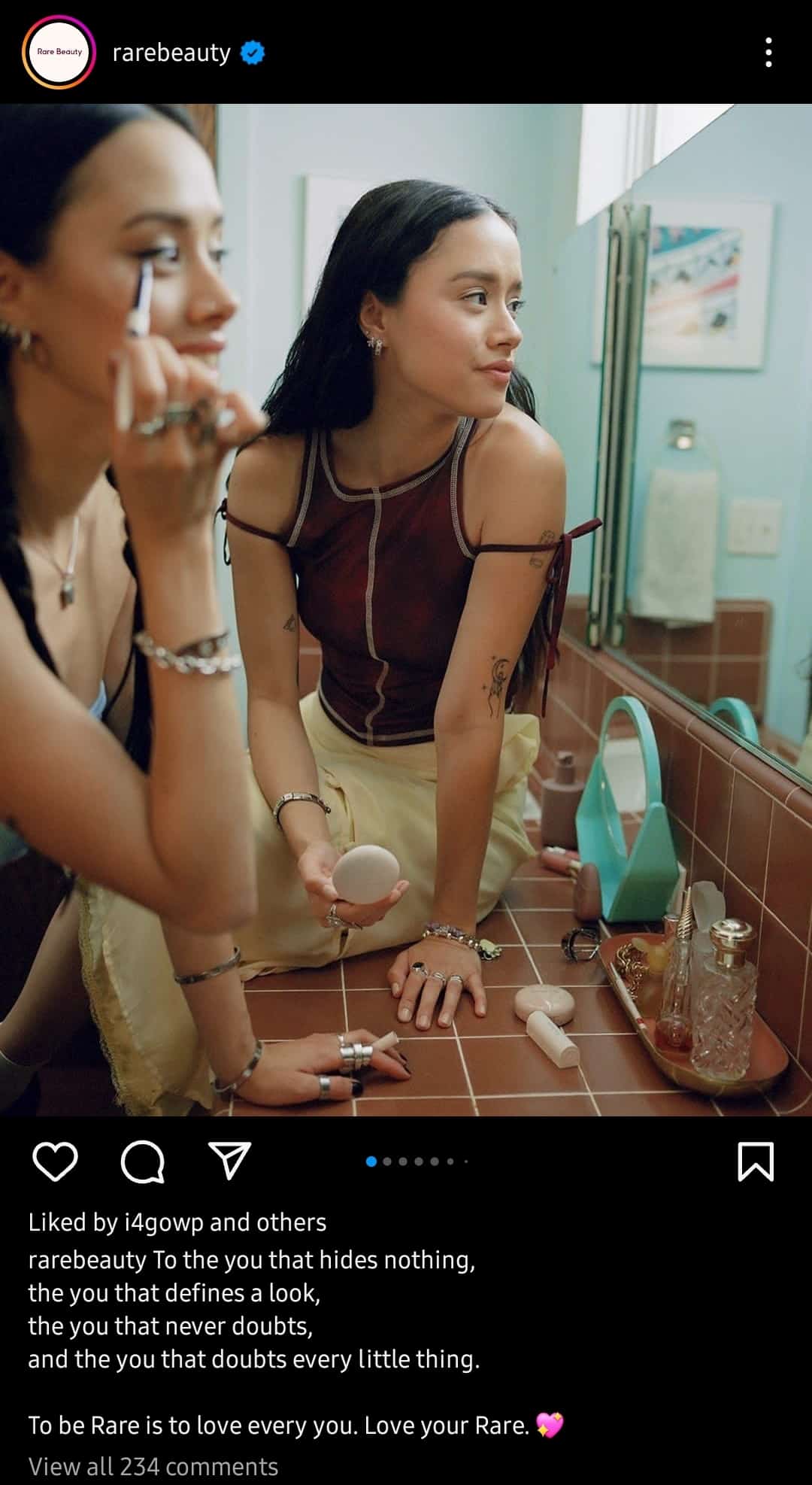In today’s fast-paced digital landscape, social media storytelling is how brands break through the noise and build meaningful connections.
The most successful brands aren’t just selling products—they’re creating emotional experiences that resonate with their audience.
Whether through relatable human stories or innovative tech-driven campaigns, social media storytelling in 2025 is more immersive and impactful than ever.
In this blog, Mady Lewellyn, Social Media Manager will review 15 brands that are mastering this craft and setting the gold standard.
What We’ll Cover:
- Why Storytelling Is Crucial for Brands Today
- Fifteen Powerful Examples of Successful Storytelling
- New Trends Shaping Storytelling in 2024
My Expert Opinion on Brands Using Social Media Storytelling the Right Way
The most effective brands use storytelling to connect emotionally with their audiences, not just to sell products. Whether it’s Nike’s sustainability efforts or Airbnb’s immersive travel experiences, these brands craft stories that align with their audience’s values and aspirations. In 2025, storytelling is more immersive, thanks to platforms like TikTok and AR technology, making it crucial for brands to stay adaptable. Authenticity and emotional relatability are key to building lasting relationships with consumers.
Action Item: Focus on creating emotionally resonant stories that align with your audience’s values, and explore new platforms to tell them in more dynamic ways.

Why is Social Media Storytelling So Important?
Stories have long been a part of our culture.
They predate television, social media, and the internet, and they hit us on an entirely different level. Why? Because they’re emotional, relatable, and captivate us in ways that dry facts simply can’t.
Social media storytelling is no different. It should be emotional, relatable, and captivating to your target audience. Researching and understanding your audience is critical to ensure your story resonates.
When done right, storytelling has the power to build a loyal community around your brand—one that’s connected to you not just for your products but for the values and emotions you evoke.
Today, with the rise of new platforms like TikTok and Threads, storytelling on social media has become even more dynamic and immersive.
Brands that are nimble in adjusting their storytelling styles to fit emerging formats tend to capture the audience’s attention faster.
Take a look at some of these brands and their social media examples.
1. Social Storytelling: Humans of New York

With over 20 million followers on Facebook and 12 million on Instagram, Humans of New York is a stellar example of social storytelling done right.
What started as Brandon Stanton’s personal photography project has now evolved into a global storytelling movement, featuring narratives from across 40+ countries.
People around the world connect with the raw, emotional stories that often get broken into multiple parts, drawing readers back for more.
Why It Works
Stanton’s stories hit all the right notes—emotional, relatable, and captivating. His success proves that great stories don’t always need fancy production, just a willingness to listen and share human experiences.
Key Takeaway
Focus on real humans and their stories. Authenticity will grab people’s attention faster than polished, impersonal content.
2. Dove: Social Storytelling
Dove has been excelling at storytelling for years. From their famous “Real Beauty” campaign to their “Self-Esteem” Project, Dove continues to be a leader in social media storytelling.
This latest campaign takes an even broader approach by addressing mental health, gender equality, and self-care for all body types and ages. Dove’s rejection of airbrushed supermodels in favor of real people with real stories set a precedent that resonates with diverse audiences worldwide.
Why It Works
Dove knows its audience and doesn’t shy away from addressing the issues they care about—like self-image, body positivity, and even fatherhood with their Dove Men+Care campaigns. By tapping into emotions, Dove connects with consumers on a deeper, more personal level.
Key Takeaway
Know your audience intimately. Speak to their struggles and triumphs in a way that is both meaningful and aligned with your brand values.
3. Heinz: Social Storytelling
Heinz may be known for ketchup, but their custom-labeled soup cans became a viral sensation. What started as a five-year campaign has now become a permanent offering, allowing customers to create personalized labels for loved ones. The brand also continues its tradition of giving back by partnering with various charities, showing that Heinz isn’t just about food—it’s about care, warmth, and connection.
Why It Works
The campaign’s success lies in its simplicity: personalized cans that carry heartfelt messages, turning an everyday product into a gesture of love. By involving their audience in the process, Heinz cultivated a sense of personal connection and loyalty.
Key Takeaway
Involve your audience in the story, and allow them to add personal touches. The more your audience feels part of the narrative, the more engaged they will be.
4. Nike: Social Storytelling
Nike’s recent storytelling continues its emphasis on sustainability through the Move to Zero initiative, which is central to its 2024 campaigns. With this initiative, Nike tackles environmental responsibility by reducing carbon emissions and waste, aiming for a future with zero environmental impact. A standout aspect of this campaign is the “Bloom Over Doom” message, which replaces fear with optimism, showcasing innovation as a solution to the climate crisis. By focusing on transforming materials and recycling processes, Nike engages customers in its journey to a greener future.
Why It Works
This narrative taps into consumer desires for brands that prioritize social and environmental responsibility. Younger generations are especially drawn to companies that align with their values, and by focusing on sustainability, Nike positions itself as a leader in ethical innovation.
Key Takeaway
If your brand can connect with the causes that matter to your audience, you’ll inspire not just customers but advocates. Storytelling about shared values creates deeper, more loyal connections
5. Lululemon: Social Storytelling

Lululemon has always had a strong social media presence, but their 2023 “Feel Grounded” campaign took things to a new level. The campaign shifted the focus from fitness to overall mental wellness, encouraging users to share their moments of mindfulness and relaxation using the hashtag #FeelGrounded.
Why It Works
Lululemon made the smart decision to evolve their brand storytelling beyond just yoga and fitness. In a time when mental health awareness is on the rise, the campaign resonated with a broader audience, giving followers a sense of community and connection.
Key Takeaway
Your brand’s story doesn’t have to stay static. Evolve your storytelling to match the changing values and needs of your audience.
6. Intel: Social Storytelling

Intel continues to excel at using social media to tell the brand’s evolving story. In 2024, they’ve pivoted to highlight their work in AI-driven technology—particularly in healthcare and renewable energy. Their Instagram showcases cutting-edge AI innovations, from diagnostic tools in hospitals to AI systems helping combat climate change.
Why It Works
By showing both their storied history and current innovations, Intel creates a narrative that portrays them as forward-thinking but grounded in decades of excellence. It’s a balance that builds trust with both tech enthusiasts and everyday consumers.
Key Takeaway
Show your evolution. Whether your brand is new or established, showcasing how far you’ve come and where you’re going is crucial for building trust and engagement.
7. Dwayne “The Rock” Johnson: Teremana Tequila

Dwayne Johnson’s Teremana Tequila highlights his journey and commitment to craftsmanship. His storytelling emphasizes authenticity and hard work, enhancing consumer trust. Johnson frequently shares behind-the-scenes content from the production process, which deepens the connection with his audience.
Why It Works
By focusing on personal narratives and craftsmanship, Teremana builds brand credibility and consumer loyalty.
Key Takeaway
Use personal stories to highlight authenticity and craftsmanship, which can enhance consumer trust and engagement.
8. Airbnb: Social Storytelling
Airbnb continues to tap into wanderlust with beautifully curated Instagram posts of unique properties worldwide. But they’ve taken it a step further by allowing hosts to share personal stories about their properties and guests to post testimonials about their stays. Recently, they introduced a new feature: immersive 360° virtual tours, giving potential travellers a more intimate look at their future stays.
Why It Works
The personalized touch, combined with aspirational visuals, makes it easy for followers to imagine themselves in these unique homes. Airbnb doesn’t just show a place to stay—it shows a potential experience.
Key Takeaway
Make your audience feel like they’re already part of the story. When you can spark their imagination, they’re much more likely to engage and convert.
9. Gillette: Social Storytelling
Taking a moment to look at the infamous campaign that has been, for a while, a divisive one… Gillette’s “We Believe: The Best A Man Can Be” campaign. It challenged toxic masculinity and aimed to promote social change by encouraging men to be better role models, sparking widespread dialogue. While it received praise for addressing important issues, it also faced backlash from customers who felt alienated, leading to mixed outcomes for the brand.
Why It Works
By addressing sensitive issues like toxic masculinity and aligning with the values of a more socially conscious generation, Gillette demonstrated boldness, generated extensive media coverage, and engaged in meaningful conversations that extended beyond product promotion, creating a lasting impression and broadening their brand narrative.
Key Takeaway
Bold, value-driven marketing can create significant impact by engaging in relevant social conversations, but it also carries the risk of alienating a portion of the audience if not aligned with their expectations or values.
10. Goldfish Crackers: AR and Storytelling
Goldfish Crackers used augmented reality on Snapchat to create an engaging game that tested teens’ attention spans. This clever use of AR technology allowed the brand to create a memorable experience while keeping the product central to the narrative.
Why It Works
It combined an innovative use of technology with a direct, relatable message, making the experience interactive and fun for users.
Key Takeaway
Using innovative tools like AR to involve consumers in your story can create memorable brand interactions that resonate deeply.
11. Rihanna: Fenty Beauty

Rihanna’s Fenty Beauty continues to disrupt the beauty industry by championing inclusivity and diversity. The brand’s launch featured an extensive range of shades catering to all skin tones, addressing gaps in the market. Rihanna’s authentic and intentional involvement in the brand resonate with consumers.
Why It Works
Fenty Beauty’s commitment to diversity and representation allows it to connect deeply with a broad audience, fostering brand loyalty.
Key Takeaway
Prioritize inclusivity in your product offerings to create a brand that resonates with diverse consumer groups.
12. Yara International: Stories of Succession
Yara International launched the “Growers for the Future” campaign, focusing on the personal stories of farmers navigating the challenges of succession. This campaign highlighted both the fears and aspirations of growers, creating a relatable narrative around sustainability and community support.
Why It Works
By personalizing the stories of individual farmers, Yara connected emotionally with its audience, fostering a sense of community and shared purpose.
Key Takeaway
When you focus on the personal stories within your target audience, you can create deeper emotional connections and a more impactful narrative
13. Apple: “Apple at Work” Campaign
Apple’s “Apple at Work” campaign reinforces its long-standing message of innovation and empowerment. By showcasing how their products enhance productivity and creativity in various professional settings, Apple maintains its narrative of changing the world.
Why It Works
The campaign aligns with Apple’s established brand identity and consistently resonates with consumers who value innovation.
Key Takeaway
Ensure your storytelling aligns with your brand’s core values to maintain authenticity and build loyalty
14. Selena Gomez: Rare Beauty

Selena Gomez’s Rare Beauty emphasizes challenging unrealistic beauty standards and promoting mental health awareness. The brand’s focus on authenticity and community engagement, particularly through platforms like TikTok, has helped create a loyal following. Products like the Soft Pinch Liquid Blush have achieved cult status, showcasing the brand’s appeal.
Why It Works
By aligning the brand with social issues that resonate with its audience, Rare Beauty cultivates a sense of belonging and empowerment.
Key Takeaway
Building a brand around authenticity and shared values can foster deep connections with consumers.
15. LEGO: “Rebuild the World” Campaign
LEGO’s “Rebuild the World” campaign emphasizes creativity and imagination through the eyes of children. By showcasing stories of kids building their unique worlds with LEGO bricks, the brand encourages innovation and problem-solving.
Why It Works
The campaign appeals to both children and adults, highlighting the joy of creativity and play, core elements of LEGO’s brand identity.
Key Takeaway
Storytelling that emphasizes creativity and play can create lasting connections with both younger and older audiences
Social Media Storytelling for Any Brand
Great storytelling is at the heart of social media success.
From emotional narratives to innovative, cause-driven campaigns, these brands prove that connection goes beyond products.
As trends like AI personalization and immersive tech grow, storytelling will only become more vital in building lasting relationships with consumers.
Now is the time to craft your brand’s unique story and turn your audience into a loyal community.
Ignite Visibility can help you:
- Craft cohesive narratives that aligns with your brand’s values, goals, and audience interests
- Designing engaging visuals, such as images, videos, and graphics, that complement the storytelling
- Creating compelling and relatable text that tells a story, including posts, captions, and messaging
- Planning, organizing, and publishing content consistently to keep the story flowing and engaging over time
- Monitoring the effectiveness of storytelling campaigns by tracking engagement, reach, and conversion metrics
Reach out to get started today!



